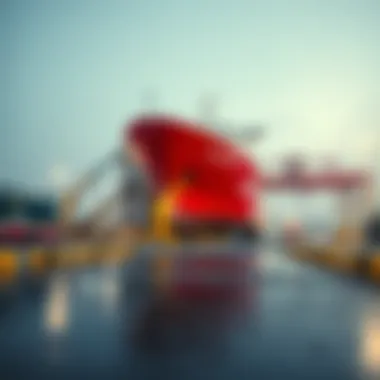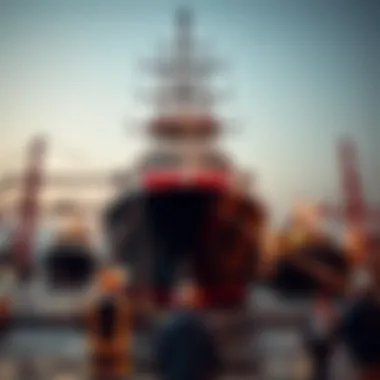Innovative Developments in Dubai's Dry Dock Sector


Intro
The dry dock sector in Dubai is shaping up to be a cornerstone of the emirate's maritime ambitions. With major investments and transformative projects on the horizon, the industry is transitioning to meet the demands of tomorrow's maritime landscape. Beyond repairing and maintaining vessels, these emerging developments aim to create a vibrant ecosystem that strengthens Dubai's position as a global maritime hub. Investors, homeowners, and other stakeholders are keeping a keen eye on the evolving scene, eagerly anticipating the economic ripple effects of these initiatives.
Market Trends and Analysis
Current Market Overview
In recent years, Dubai's dry dock sector has seen a steady influx of investment, fueled by an increase in maritime trade and tourism. The blend of traditional shipbuilding practices with modern technology is inching the industry toward unprecedented efficiency. Companies like Dubai Shipbuilding and Dubai Drydocks World are pioneering innovations in ship repair and refurbishment, positioning themselves to cater to larger vessels and advanced designs.
Economic diversification policies have also bolstered the sector, steering away from reliance on oil. The government’s focus on promoting trade logistics and enhancing regulatory frameworks is creating an atmosphere ripe for growth. Additionally, specialized maritime services are emerging as key market players, focusing on everything from welding and painting to comprehensive repair services.
"Dubai is not just a port; it's an entire experience for maritime professionals and leisure seekers alike."
Future Market Predictions
The foresight for Dubai’s dry dock industry is optimistic. Analysts predict a compound annual growth rate that defies previous benchmarks, potentially hitting between 7-10% in the next few years. This surge will likely be driven by regional developments surrounding the Expo 2020 and the expanding fleet of shipping companies looking to establish a footprint in the Middle East.
As countries ramp up their green technologies, environmental considerations are becoming an integral part of this sector’s growth. Enhancements in sustainability—ranging from eco-friendly materials to waste management systems—are shaping not just market demand but also project viability. Stakeholders can expect government incentives for projects that promote environmental responsibility.
Investment Opportunities
Emerging Neighborhoods
Investors looking into Dubai's dry dock projects should take note of emerging neighborhoods that are set to flourish alongside these developments. Areas such as Jebel Ali—already a bustling industrial hub—are seeing significant infrastructure upgrades. Additionally, as Dubai's maritime activities grow, parts of Dubai Maritime City are gaining traction, becoming attractive for residential and commercial investments.
Types of Properties for Investment
Potential investment avenues in this sector are as varied as the ships that sail through Dubai's waters. Some options worth considering include:
- Industrial Properties: Warehousing and distribution centers that support dry dock operations.
- Commercial Spaces: Offices and retail spaces catering to maritime businesses and their consumers.
- Residential Developments: Housing for expatriates working in the area, with the possibility of high rental yields given the continued influx of maritime professionals.
Overview of Dubai's Maritime Landscape
Dubai's maritime landscape represents a dynamic blend of tradition and innovation, serving as a vital artery for commerce and trade in the region. Historically, its strategic location along the shipping routes connecting the East and West has been a boon for its development as a maritime hub. The subsequent advancement of infrastructure across various sectors, notably in dry docks, has further solidified its standing on the global stage.
The dry dock sector, in particular, is not merely a facility for ship repairs; it symbolizes Dubai's ambitions to elevate its maritime capabilities. Given the increasing demand for efficient shipbuilding and maintenance operations, understanding this landscape helps in grasping how investments shape the economy. The intricate tapestry of economic implications stretches from job creation to supporting ancillary industries, showcasing the undeniable link between maritime facilities and urban development.
Historical Context of Dry Docks in Dubai
The inception of dry docks in Dubai dates back to the early 20th century when the first construction was erected at the Dubai Creek. Initially, the dry docks served mainly local vessels engaged in traditional trade, laying the groundwork for a burgeoning maritime industry.
As the port's capacity increased and international trade blossomed, Dubai witnessed an exponential growth in its dry dock facilities. By the 1970s, significant advancements ushered in larger docks capable of handling modern vessels, reflecting the emirate's determination to adapt to global standards. The establishment of Dubai Maritime City in the early 2000s marked a crucial turning point, consolidating the emirate's reputation as a leader in maritime services and construction.
Today, Dubai's dry docks not only cater to repair and maintenance but also engage in high-value naval construction. The legacy of innovation began years ago, but it continues to influence current projects aimed at further enhancing service capabilities.
Significance of Dry Docks in Urban Development
Dry docks have a far-reaching impact on urban development within Dubai. They act as a catalyst for economic growth by attracting local and international investment. As these facilities expand, they create a ripple effect; supporting jobs for skilled workers, fostering a skilled labor market, and stimulating sectors such as logistics, manufacturing, and tourism.
Moreover, the environmental considerations around dry docks today highlight a growing awareness and responsibility. As new projects emerge, there’s a notable shift towards sustainable practices, aligning with global trends in environmental awareness. In addition, the infrastructure associated with these dry docks contributes to the overall urban fabric, incorporating smart technology and innovative designs.
To encapsulate, dry docks in Dubai play an essential role not only in maritime activities but also as crucial elements of urban planning, reflecting the interplay between economic aspirations and sustainable development.


"The strategic development of dry docks in Dubai highlights the emirate's commitment to becoming a leading maritime hub in the region and beyond."
Current Trends in the Dry Dock Sector
The dry dock sector of Dubai is not just expanding; it's evolving in tandem with global trends and technological advances. This dynamic environment is shaping the future maritime landscape. Innovation isn’t merely a buzzword here; it’s the lifeblood of ongoing projects that emphasize efficiency, sustainability, and economic potential. Investors and stakeholders are showing increasing interest, realizing the benefits these trends can provide in terms of opportunity and growth.
Technological Innovations Shaping Dry Docks
In recent years, technology has taken center stage in Dubai's dry docks. The introduction of automated repair systems, robotics, and IoT (Internet of Things) has transformed the traditional dry dock operations. Automation speeds up ship repairs and maintenance, making tasks that once required extensive manpower more efficient. Additionally, incorporating IoT allows for real-time monitoring of vessel conditions, reducing the chance of unexpected repairs and improving overall time management.
Among innovative projects is the use of drones for inspections, which allow for quicker assessment of a vessel's condition without the need for divers, further enhancing safety and reducing turnaround time. Also noteworthy is predictive maintenance technology, where data analytics can pinpoint potential issues before they become critical. This proactive rather than reactive approach can save both time and money, ensuring Dubai maintains its reputation as a hub for maritime excellence.
"Technological advancements aren't just shaping the future; they are redefining the standards of safety and efficiency in dry docks."
Impact of Global Maritime Trends on Dubai
To appreciate the potential of Dubai's dry dock sector, one must consider the global maritime trends influencing it. As the shipping industry shifts towards larger vessels, there is an escalating demand for advanced dry docks capable of accommodating such ships. Consequently, Dubai is upgrading its facilities to include deeper and larger docks, which will cater to these colossal vessels effectively.
Moreover, the rising emphasis on sustainable practices worldwide means Dubai's dry docks are also evolving in their environmental approaches. This includes adopting cleaner technologies and practices that align with global goals for reducing environmental impacts. These adaptations not only position Dubai favorably in global markets but also attract environmentally conscious investors.
Furthermore, trends like increased maritime trade with emerging markets in Asia and Africa favor Dubai's strategic location as a pivotal shipping center. The government is also actively promoting policies that support growth in this sector, helping it align with broader economic strategies. The outcome? A robust dry dock sector that serves not just local needs but has an eye on becoming a global leader in maritime services.
All these trends are interwoven, creating a complex yet fascinating tapestry that showcases Dubai’s potential. For investors, real estate developers, and maritime professionals, understanding these currents is essential to navigate the future successfully.
Key Upcoming Projects in Dubai's Dry Dock Sector
The development and expansion of dry docks in Dubai is set to reshape the maritime sector significantly. These projects not only promise to enhance the efficiency of ship repairs and maintenance but also aim to position Dubai as a crucial hub in global maritime trade. A closer examination reveals that these upcoming initiatives are strategically planned to meet the increasing demand for maritime services while also aligning with Dubai’s vision for sustainable growth. Let's dive into the substantial aspects of these projects.
Project Descriptions and Specifications
Project A Overview
Project A, which is currently under construction, represents a significant leap forward in the capacity and capability of Dubai's dry dock facilities. It focuses on integrating cutting-edge technology alongside traditional dry docking processes, significantly reducing turnaround times for vessel maintenance. A key characteristic of this project is its incorporation of automated systems, which not only enhance operational efficiency but also minimize human error.
The unique feature that sets Project A apart is its commitment to eco-friendly practices. By utilizing renewable energy sources during operations, this project echoes the industry's shift towards sustainable practices. While the potential advantages are vast, including increased productivity and lower operational costs, some critics may wonder about the initial investment that such technologies require.
Project B Overview
Project B is another ambitious venture aimed at expanding the current capabilities of Dubai's dry docks. This project focuses on specialized services for large cargo ships, intending to cater specifically to the burgeoning shipping industry. Its standout characteristic is the design of docking facilities that can accommodate vessels of unprecedented size, which addresses the growing trend of megaships in global trade.
The project also incorporates advanced maintenance technologies, allowing for real-time diagnostics of vessel systems while undergoing repairs. This is beneficial because it enables quicker adjustments and repairs, ultimately getting ships back on the water faster. However, the large scale and complexity can pose challenges related to project management and logistics that stakeholders must consider.
Project Overview
Lastly, Project C is set to focus on integrating digital solutions into dry-docking procedures. It's about taking advantage of data analytics and IoT technologies to streamline processes. This project's innovative approach includes creating a digital twin of the dry dock, allowing management to monitor and analyze operations in real time. The dynamic monitoring can significantly reduce downtime and lower costs for ship maintenance.
The project's advanced digital integration is beneficial in making informed decisions based on data, a true game-changer in the maritime industry. However, the reliance on digital technologies also brings forth concerns about cybersecurity, necessitating rigorous protective measures to safeguard sensitive information.
Timeline for Completion
The timelines for these critical projects vary, reflecting their scope and complexity.
- Project A is expected to reach completion by the end of the next fiscal year, projecting enhanced operational capacity soon after.
- Project B anticipates completion within a two-year timeframe, aligning its launch with predicted growth in maritime traffic.
- Project C, while slightly behind the others, is progressing steadily with a target date of three years from now to fully implement its digital systems.
These projects collectively contribute to a unified vision for Dubai—a vision of robust maritime infrastructure that not only elevates the local economy but also boosts Dubai's status as an international maritime nexus. The upcoming developments in the dry dock sector underscore a commitment to harnessing innovation and sustainability, ensuring a promising future for all stakeholders involved.
Investment Opportunities in New Dry Dock Projects
As Dubai's maritime sector continues to grow and modernize, drifting into the spotlight are the investment opportunities presented by new dry dock projects. The allure of this sector lies not only in the potential returns but also in its strategic significance to the region’s economy and infrastructure. With the aim of creating a robust maritime hub, Dubai has laid out an ambitious roadmap that integrates significant investment into its dry docks, positioning them at the heart of its wider vision for economic diversification and sustainability.


Investing in dry dock projects can provide a safety net against economic fluctuations, especially in a city that has historically displayed resilience amid global challenges. Stakeholders must consider specific factors when navigating this lucrative terrain. Key considerations include:
- Market Demand: With an expanding global shipping industry, the demand for repair and maintenance facilities is on the rise.
- Technological Integration: The application of cutting-edge technologies in dry docks not only expedites operations but also enhances service quality, making them more appealing to potential clients.
- Regulatory Framework: The government’s commitment to creating a supportive legislative environment reinforces the attractiveness of investment.
The dry dock sector also stands out for its potential to generate sustainable models of growth. When projects align with environmental goals, they not only fulfill regulatory requirements but resonate with modern investors who are increasingly conscious of their carbon footprint. As we delve into the financial specifics, it’s paramount to understand how the capital that pours into these projects is structured and what it entails.
Capital Requirements and Financial Models
A clear understanding of capital requirements is essential for any investor stepping into Dubai’s dry dock landscape. The initial investment cost can vary greatly depending on several factors, such as the size of the dry dock, the technology deployed, and the level of service being offered. Typically, these investments run into millions of dollars, reflecting the scale and sophistication of modern maritime operations.
Investors can explore several financial models to fund their projects:
- Joint Ventures: Partnering with established maritime firms can mitigate risks and leverage expertise and networks.
- Public-Private Partnerships: Collaborating with government entities may provide access to incentives and regulatory support, easing the financial burden.
- Debt Financing: Securing loans or lines of credit can help finance construction and initial operations, albeit with a careful assessment of potential revenue flows.
In assessing the capital stack, stakeholders must also consider ongoing operational costs, from maintenance to workforce training. A well-planned financial model can create a resilient foundation for future returns.
Potential Returns on Investment
Investors naturally seek clarity on potential returns, and the dry dock industry is no different. The returns often materialize through various channels:
- Service Fees: Repair and maintenance companies are consistently seeking dry dock services, leading to predictable revenue streams.
- Leasing Agreements: The option of leasing out dry dock facilities can create a steady income that adds to overall profitability.
- Strategic Positioning: Being situated in a globally recognized shipping hub can attract international clients, further extending profit margins.
It’s worth noting that while returns can be enticing, they are not without risk. External factors, such as fluctuating oil prices, geopolitical tensions, and changing maritime regulations, can influence profitability.
Yet, conducting thorough due diligence can significantly enhance the probability of securing favorable returns. By approaching investments in the dry dock sector with a clear strategy and an understanding of market dynamics, investors can unlock significant value in this fast-evolving area.
As Dubai continues to invest in its maritime infrastructure, staying abreast of trends and projections will be critical for making informed decisions. In this way, the dry docks of Dubai are not only becoming engines of economic growth but also beacons of investment potential.
Environmental Considerations in Dry Dock Projects
In the rapidly advancing domain of Dubai's dry dock industry, environmental considerations play a crucial role. As the region expands its maritime infrastructure, balancing development with ecological integrity becomes a pressing necessity. This section delves into sustainable construction practices and their potential impacts on marine ecosystems, vital both for compliance with international standards and for meeting the expectations of a more environmentally conscious investor base.
Sustainable Practices in Construction
Sustainability is no longer a buzzword but a fundamental principle guiding new construction in the dry dock sector. Practices such as using recycled materials in dock construction and implementing energy-efficient technologies are gaining significance. For example, incorporating solar panels for energy generation or utilizing water recycling systems can lead to significant reductions in resource consumption.
Moreover, green building certifications, like LEED (Leadership in Energy and Environmental Design), are becoming a benchmark for these projects. Adhering to such standards not only helps in reducing the environmental footprint but also appeals to stakeholders who prefer environmentally responsible investments.
Additionally, constructing dry docks that account for climate resilience is essential. This means designing structures that can withstand rising sea levels or more extreme weather patterns, which are increasingly linked to climate change. By addressing these factors during the planning phase, developers can ensure long-lasting and efficient infrastructure that meets future demands.
Impact on Marine Ecosystems
The construction of new dry docks must also carefully consider their impact on local marine ecosystems. Disrupting habitats during the building process can lead to detrimental effects on biodiversity. For instance, dredging operations can resuspend sediments and release toxic substances that might harm fish populations.
Implementing mitigation strategies becomes vital in this scenario. These might include:
- Timing Construction: Carrying out major construction work during off-peak seasons for marine life to minimize disruption.
- Creating Artificial Reefs: In some instances, strategically placed underwater structures can benefit marine life, providing new habitats and fostering biodiversity.
- Monitoring and Research: Continuous monitoring of the ecological impact post-construction can help identify any unforeseen issues, allowing for rapid response to mitigate negative effects.
"A well-planned dry dock project can enhance both infrastructure and environmental stewardship, creating a symbiotic relationship that benefits developers and ecosystems alike."
The long-term health of Dubai's marine ecosystems is directly tied to responsible practices in the dry dock sector. As stakeholders become more aware of the environmental ramifications, the pressure will mount for projects to adopt more sustainable methodologies. Ultimately, those who can navigate these complexities will not only fulfill regulatory requirements but also ensure a more robust and appealing investment landscape for the future.
Challenges Facing Dubai's Dry Dock Projects


In the context of Dubai's ever-evolving dry dock sector, the challenges that emerge are not merely roadblocks but are indicative of the intricate web of operations within the maritime industry. Addressing these challenges is vital for ensuring sustainable growth, safeguarding investments, and promoting compliance with international standards. The sector's growth phase, with numerous projects on the horizon, hinges on understanding these hurdles and strategizing accordingly.
Regulatory and Compliance Issues
One of the foremost challenges facing dry dock projects revolves around the regulatory and compliance landscape. The maritime industry operates under a complex framework of local and international laws, including safety regulations, environmental standards, and labor laws. Compliance with these regulations is non-negotiable and, in some instances, leads to substantial delays and increased costs.
Key regulatory frameworks include the International Maritime Organization (IMO) conventions and local regulations enforced by the UAE authorities. These regulations often require extensive documentation and adherence to safety protocols. Non-compliance can result in stiff penalties, project halts, and potential reputational damage. This can be particularly detrimental for new investors who might find the intricate regulatory processes daunting.
To navigate these regulatory waters successfully, stakeholders must be well-informed about both the evolving regulations and the requisite compliance measures. Engaging legal experts who specialize in maritime law can be beneficial. It also allows for a proactive approach to anticipating compliance demands rather than being reactive to potential penalties.
Economic and Geopolitical Factors
The economic and geopolitical landscape deeply impacts the dry dock sector in Dubai. Global economic trends influence maritime trade volumes, which in turn affect the demand for dry dock services. Sluggish global economic conditions or trade disputes can directly impact the level of maritime activities, putting pressure on local dry docks.
Moreover, the geopolitical climate in the Middle East can lead to uncertainties in investments. Tensions in neighboring regions and changing government policies can disrupt supply chains and raise operational costs. This volatility often leads to cautious investor behavior, as potential stakeholders weigh the risks of commitment against the backdrop of fluctuating market conditions.
Investors and stakeholders in the dry dock industry must pay close attention to global market trends and geopolitical developments. Establishing adaptable business models and risk management strategies can mitigate these uncertainties. More importantly, continuous market analysis helps stakeholders make informed decisions, ensuring resilience against unexpected financial strains and fostering long-term sustainability.
"Understanding the challenges is just as crucial as seizing the opportunities within the dry dock sector. Both are intertwined in the path to success."
Future Outlook for Dubai's Dry Dock Sector
The future outlook for Dubai's dry dock sector is not just a crystal ball gazing exercise; it’s a critical lens through which stakeholders—investors, policymakers, and maritime entrepreneurs—can gauge potential shifts in infrastructure, investment dynamics, and environmental strategies. With a slew of ambitious projects on the horizon, the dry dock sector serves as a barometer of economic vitality in the broader maritime picture of Dubai.
Long-term Projections and Trends
As the world navigates toward a more eco-conscious and technologically advanced era, Dubai's dry dock sector is expected to follow suit with specific trends shaping its future. Here are some projections that stakeholders might find particularly relevant:
- Increased Automation: Innovations in automation technology are likely to streamline operations. Robotic systems could take over repetitive tasks, enhancing productivity and reducing operational costs.
- Sustainability Standards: Projects that don’t comply with international environmental standards may find it tough to adapt. Future dry dock facilities are anticipated to integrate sustainable practices, from using green building materials to implementing effective waste management systems.
- Collaborative Ventures: Public-private partnerships might become the norm as Dubai seeks to enhance its global competitiveness. By pooling resources and expertise, stakeholders can mitigate risks and share the financial burden of large-scale projects.
- Expansion of Service Offerings: As more operators enter the market, there’s likely to be diversification in the services offered. This could involve specialized repairs for larger vessels or upgrades to facilities that support modern marine technologies.
In addition, geopolitical stability in the region will play a crucial role in attracting foreign investments, which is vital for this sector's growth. The dry docks' ability to accommodate increasing capacity will also depend on judicious management of existing resources while planning for future demands.
Strategic Planning for Expansion
Strategic planning remains a cornerstone for the sustainable growth of Dubai’s dry dock sector. Several considerations come to the forefront for effective expansion strategies:
- Market Analysis: Understanding market needs will help shape project specifications. Insights from potential customers can drive innovation.
- Investment in R&D: Allocating resources toward research and development can enhance the services provided. New materials and techniques could revolutionize how dry docks operate.
- Regulatory Compliance: Keeping abreast of national and international maritime regulations will be critical for new projects. Compliance minimises risks and helps in achieving certifications that could attract more clients.
- Risk Management: Evaluating potential risks—whether economic downturns or supply chain disruptions—can guide the decision-making behind expansions.
A coherent strategic framework enacted early on may contribute significantly to elevating Dubai as a premier global maritime hub. As the city embraces its ambitious visions for 2030 and beyond, the dry dock sector could serve as a critical player in reinforcing the emirate’s reputation on the world stage.
Effective strategic planning is key to ensuring that Dubai's dry dock facilities not only meet current demand but are also positioned for long-term success.
Epilogue and Recommendations
In closing, the landscape of Dubai's dry dock sector demonstrates remarkable potential for investment and development, making it an area of keen interest for numerous stakeholders. As we explored throughout the article, various emerging projects hold the promise of enhancing the maritime infrastructure and subsequently the local economy. Drawing clear insights from these developments allows investors, homeowners, expatriates, agents, and analysts to make well-informed decisions that align with their goals and expectations.
Summarizing Key Insights
Here are the key takeaways from our examination of the emerging projects:
- Strengthened Infrastructure: The planned enhancements to the existing dry dock facilities indicate a significant investment in Dubai's maritime capabilities. Infrastructure improvements will enable larger vessels to dock, leading to increased maritime traffic.
- Economic Impact: With new projects on the horizon, there is an expected increase in job creation across various sectors. This can fuel economic growth not just locally, but also at a regional scale.
- Sustainability Matters: Environmental considerations are now paramount in project planning. Companies are increasingly prioritizing sustainable practices to minimize the impact on the delicate marine ecosystems surrounding Dubai.
- Investment Opportunities: Investors are presented with lucrative opportunities in the dry dock sector. Potential high returns, combined with strategic partnerships, can lead to fruitful ventures.
Guidelines for Stakeholders
For those looking to engage with the emerging projects in Dubai’s dry dock sector, we recommend the following actions:
- Research Thoroughly: Take the time to understand the market trends and regulations associated with dry dock investments. Resources such as Wikipedia and local government websites can provide valuable insights.
- Engage with Local Partners: Form alliances with local enterprises familiar with the landscape. They can offer guidance and insights that outsiders might miss.
- Monitor Regulatory Changes: Stay attuned to any shifts in policies that may impact the dry dock sector. Regulatory compliance will be crucial for long-term success.
- Prioritize Sustainability: Explore projects that incorporate eco-friendly practices, as these are likely to gain more traction and support from both consumers and regulators.
- Invest Wisely: Whether it’s in terms of finances or time, ensure that any investment aligns with your long-term strategic goals.
In summary, the confluence of emerging projects—doubly coupled with investments in sustainability—positions Dubai as a formidable player in the global maritime development arena. With disciplined strategies and a keen eye on future trends, stakeholders can navigate this promising terrain adeptly.







